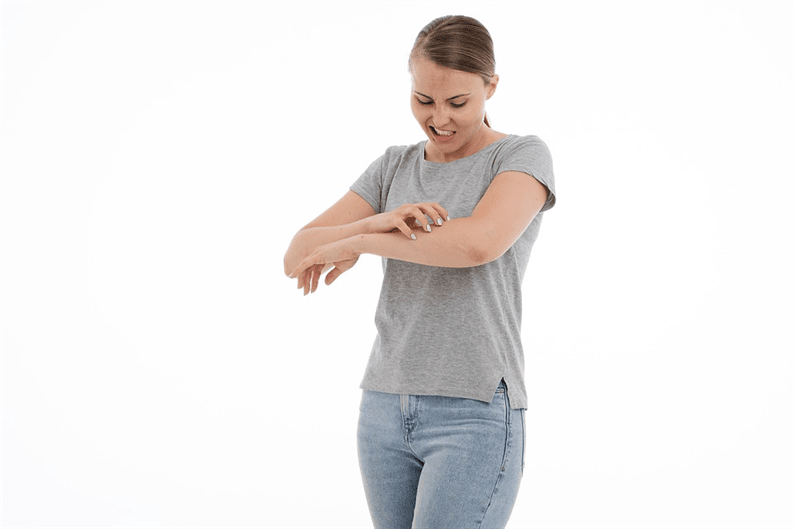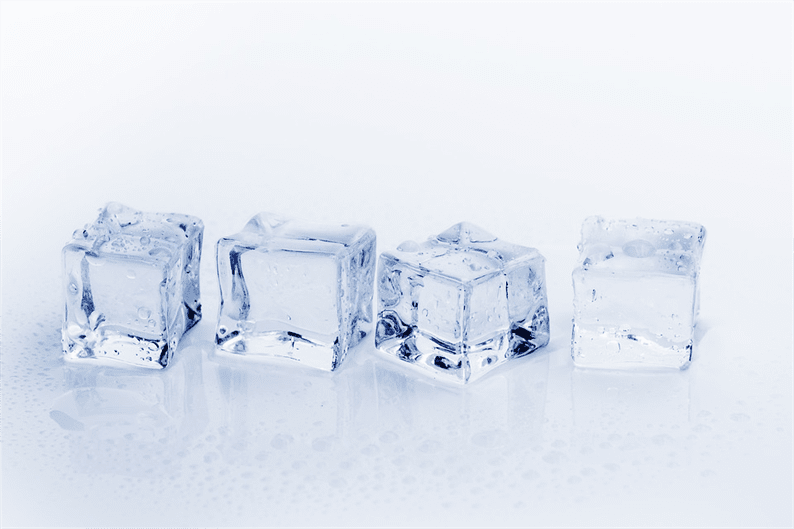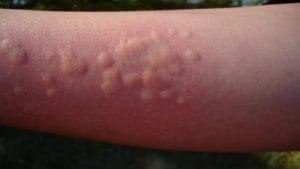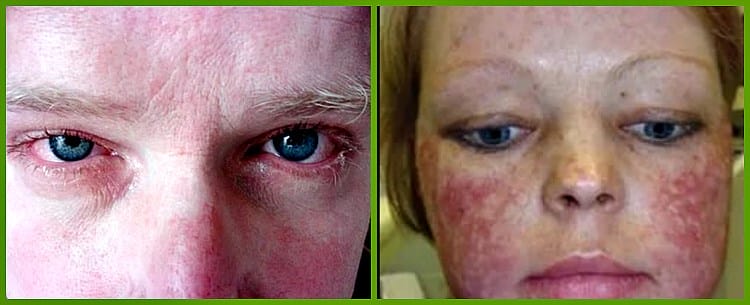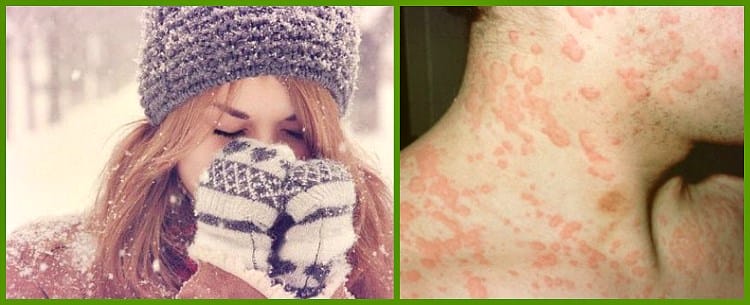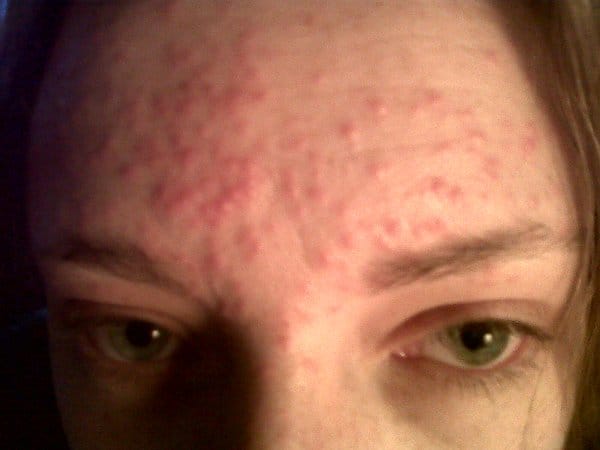Cold allergy – what is it?
This is a pathological reaction of the immune system to a physical catalyst, in this case, to low temperatures. In this case, the symptoms of the disease do not necessarily occur in winter. Sometimes the symptoms are fully manifested after washing or washing dishes, or even when drinking ice drinks.
Research confirms that after direct contact with a physical stimulus, the amount of histamine in the blood rises.
The causes of cold allergy should be looked for in the same place as the causes of any pathology of the immune system.
Cold allergy is always a marker of malfunctions in the body; in a healthy person, physiological reactions to neutral physiological stimuli are always within normal limits.
One of the main provocateurs of immune system disorders is stress. At the same time, stress does not always imply a psychological disorder; stress can be a sudden change in climate, pregnancy, or even a respiratory illness. For example, it is often the first time a cold allergy is encountered after a pathology.
For the onset of the disease, it is necessary to have provoking factors, for example:
- the patient already has other allergies;
- there are sources of chronic infection in the body;
- a history of endocrine pathologies and dermatological diseases.
Thus, any burden on immunity with the appearance of a provoking factor can turn into a cold allergy.
| Symptoms of a cold allergy rash |
Reasons for reaction to cold
- Long-term chronic diseases: sinusitis, sinusitis, caries, tonsillitis;
- Disruptions in the endocrine system;
- Weakening of the immune system;
- The presence of helminths in the human body;
- Pathology of the kidneys, diseases of the gastrointestinal tract, liver and other organs;
- Colds, stress and cancer;
- Hereditary predisposition;
- Infectious diseases: chickenpox, mumps and pneumonia;
- Allergy to dust, animal hair, pollen;
- Long-term use of antibiotics;
- Genetically programmed increased permeability of the skin and mucous membranes.
Cold allergy reasons
Cold allergy is not known to many residents, but it is not uncommon. Such an allergy is not contagious and very rarely turns into a chronic form, but it is still important to timely detect the causes of this manifestation.
Main reasons:
- Dysfunction of skin cells that are very close to the surface of the skin. The main reason for such changes may be a decrease in the protective functions of the body, which provokes not only cold allergies, but also an increased risk of infections and diseases for the body;
- Eating cold food or exposure to low temperatures on the skin – it can be wind, rain, snow, frost;
- Abrupt movement from a warm room to a cold one
- Frequent interaction with cold water – when washing dishes, washing, bathing in cold water and other situations;- Severe stress – most often people who suffer from cold allergies are people who are constantly exposed to stress, depression, suffer from frequent decreases in the strength of the immune system.
Factors that trigger the development of cold allergy
Several groups of factors are known that can provoke allergy to exposure to low temperatures.
These include:
- Propensity to allergic reactions of various origins:
- vegetable;
- household;
- food;
- medicinal
- Recently transferred diseases that were infectious in nature.
- Frequent violations of the functions of the ENT organs or the gastrointestinal tract, helminthiasis.
- Endocrine diseases or oncology.
- Skin diseases that are chronic.
- Genetic factor.
How to identify a cold allergy?
Cold allergy is not always diagnosed the first time, since the symptoms can be identical with other diseases, such as colds or allergic manifestations, which are triggered by other factors.
Cold allergies can be diagnosed at home. Methods for determining the disease depend on the type of urticaria or its severity.
The main diagnostic method is the test with a piece of ice. It is applied to the skin area for 12-15 minutes, after which it is removed. If there is redness or other changes in the skin, the test can be considered positive.
For chronic or familial allergies, these tests may be ineffective, so it is best to undergo clinical studies for antibodies to cold. For the study, the patient’s blood serum will be required.
Symptoms and Signs
A symptomatic picture arises immediately after interaction with an irritant, that is, with a low temperature.
It is necessary to differentiate cold allergy from irritation arising from wind or components that make up the cold liquid.
Like any immune reaction, cold allergy is accompanied by a deterioration in general health, shortness of breath. A persistent decrease in blood pressure is often noted, which, in turn, can cause headaches, drowsiness, and decreased performance.
Local signs of an allergic reaction to cold are expressed in the appearance of a rash that itches and itches. It usually has a pronounced pink tint and looks like hives. It is able to localize in areas that are more susceptible to direct contact with low temperatures – hands, face. Or form in places with thin sensitive skin, for example, on the elbows, inner thighs.
Also, pathologies may be accompanied by inflammation of the mucous membrane of the nose and eyes.
Cold allergy test
Therefore, it is very important for both the doctor and the patient to determine the nature of the allergic reaction in time. For this, along with complex studies using special equipment, there are fairly simple methods. If you have a cold allergy, you can check at home: put a piece of ice on the elbow for 10-15 minutes, and if hives appear, then we can assume that you are predisposed to cold allergies.
But if in doubt, you need to consult a doctor, allergic diseases require laboratory blood tests.
Diagnostics
If a cold allergy is suspected, the patient should be consulted by an allergist. To confirm the diagnosis, a cold test is performed: a small piece of ice is placed on the patient’s skin and left for 3-5 minutes. If the test is positive, typical cold urticaria develops in the area of contact of ice with skin. If necessary, pH-metry of the skin and dermatoscopy of the elements of the rash are additionally performed.
A cold test helps to determine allergies to cold: a piece of ice is applied to the skin for a while
A blood test allows you to determine in the serum the presence of proteins specific for cold allergy (cryoglobulins, cryofibrinogen, cold antibodies).
In some patients, an exacerbation of cold allergy may be accompanied by the appearance of blood proteins in the urine (hemoglobinuria).
To identify the underlying disease that caused the allergy to cold, the patient is referred for consultation to narrow specialists (gastroenterologist, gynecologist, urologist, dentist, endocrinologist, etc.).
Allergy to cold is diagnosed several times more often in women than in men. She usually manifests at the age of 20-30.
If indicated, an additional laboratory and instrumental examination is carried out, which may include:
- bacteriological culture of discharge from the nasopharynx;
- bacteriological analysis of feces
- general analysis of feces and urine
- Ultrasound of the abdominal and pelvic organs;
- pharyngoscopy;
- rhinoscopy;
- fibroesophagogastroduodenoscopy (FEGDS).
Skin allergies to cold should be differentiated from dermatitis caused by other causes (contact, drug, atopic dermatitis), as well as psoriasis.
Cold allergies
Cold allergy is characterized by a variety of types and forms of manifestation
Cold dermatitis – the skin is itchy and itchy. With a severe form of the disease, swelling of the whole body may be observed.
Cold rhinitis – accompanied by the discharge of fluid from the nose, frequent sneezing, general weakness and headaches; nasal discharge is observed only in the cold, when a person enters a warm room, the runny nose stops;
Cold conjunctivitis – on frosty days, eyes can be very painful and watery;
Cold asthma is the most dangerous type of allergy, which is accompanied by asthma attacks and severe shortness of breath;
Erythema cold (urticaria) – characterized by severe redness of the skin and severe soreness in certain areas of the body.
Cold urticaria is divided into several types.
Acute or chronic. With this type of allergy, severe irritation, rash and itching begins on the face and hands, and blisters appear. Individual parts of the body may blush, outwardly it looks like insect bites. Rashes are often accompanied by lethargy, chills, painful sensations in the joints and muscles. Flare-ups can last for weeks or even months while it’s cold outside.
Recurrent. It usually occurs at certain times of the year – in autumn, winter and cold spring (most often manifests itself in the period from early autumn to mid-spring). However, exacerbations can occur at different times of the year, depending on the air temperature. An allergic reaction to cold water can get worse any season.
Reflex. It occurs exclusively when the whole body is cooled, but, at the same time, rashes can appear only on one part of the body.
Hereditary. Passed down from generation to generation. The disease is expressed in the form of maculopapular rashes and burning. Sometimes allergies are accompanied by fevers, chills, pain in the joints.
Features of hereditary allergy: it is a genetically programmed gene mutation; occurs with slight hypothermia (draft, light wind flow); is not a lightning-fast response to an allergen, it can develop for several hours; characteristic inflammatory changes in laboratory parameters (leukocytes, CRP, ESR); occurs against the background of inflammatory diseases; negative provocative ice tests.
Cold allergies
Cold allergy is expressed in different forms and varieties, which have their own distinctive characteristics.
Acute and chronic is a type of allergic manifestation, which is characterized by a sudden acute onset, accompanied by the desire to scratch parts of the body: on the face, arms, legs, sometimes itching spreads throughout the body.
A blister will pop out in the places of scratching. After that, small redness, resembling a nettle burn, scatters over the body. Severe forms of the disease are accompanied by a decrease in immunity, the appearance of chills, aching joints, muscle pain. The heartbeat becomes more frequent, weakness appears in the body.
The chronic stage of the disease usually lasts several weeks or even several months. People suffering from a chronic form, from October to April, are forced to fight their illness.
Contrary to popular belief, cold allergies can occur at any time of the year, not just in winter. The chronic stage of the disease can manifest itself with sharp temperature fluctuations. For example: a person baked in the sun for a long time, then went into the shade or into a cool building, and immediately became covered with red spots.
Cold conjunctivitis is an allergic response, manifested in the form of pain in the eyes and a strong discharge of tears.
Recurrent urticaria is a type that occurs seasonally. It can overtake a person in the autumn, winter, and spring, 1-2 times a season there is a relapse. Often, in warm summer weather, relapse occurs as a result of contact with cold water.
Reflex cold urticaria is a reflex manifestation in the cold, similar to cholinergic urticaria. Appears with general hypothermia or even certain parts of the body. Surprisingly, the response in the form of a rash does not appear in the place of exposure to cold, but around it.
Cold dermatitis – this type is manifested by the desire to comb everything and, if it is impossible to control this desire, it leads to swelling of the combed skin areas.
Familial cold urticaria is a fairly unique type of urticaria that is transmitted at the genetic level, with a dominant type of inheritance from blood relatives. Climbs out on the skin in the form of a papular-spotty rash, which is accompanied by a burning sensation.
Concomitant signs are fever and chills, joint aches, increased white blood cell count. Medicine knows the rarest type of disease, which manifests itself only after more than 24 hours, from the moment of physical exposure to cold. Therefore, familial urticaria is sometimes confused with idiopathic urticaria.
Erythema cold is redness of the skin (erythema). A characteristic feature of this type of allergy is pronounced painful sensations upon contact with the affected areas of the skin.
Cold coryza — is accompanied by nasal congestion that occurs exclusively in cold air. At the same time, a person does not have other symptoms of acute respiratory viral infections or an inflammatory disease, when changing his location, when the cold is replaced by heat, the runny nose disappears.
It should be said that the above symptoms can be perceived as the body’s protection from the cold, inherent in nature, but nevertheless, this defensive reaction is not a small discomfort, which every person notices.
Cold allergy symptoms and treatment
It turns out that it is not so easy to determine what a cold allergy looks like, because often it hides under the mask of acute respiratory infections and acute respiratory viral infections, colds and dermatitis. It happens that a person on his own is not able to determine what he is sick with, but seeing the symptoms, he prescribes treatment for himself. Don’t make your own healing decisions at home.
Cold allergy symptoms or main signs of manifestation
Sometimes, when moving from a warm room to the street, her symptoms immediately appear, then unpleasant pulling pains in the facial and cervical muscles, then a sharp pain in the frontal and occipital region. And in a warm room after 15 minutes, the manifestations of these signs disappear.
It is curious that these signs are generated even by an unheated bed or chilled drinks. Itchy, reddish rashes, peeling of the skin of the inner thigh, itching and redness under the knee immediately appear.
How does cold allergy manifest in adults? Cold allergies on the hands are more common in adults. It is expressed first in the desire to scratch the skin, which soon thickens and coarsens, dryness appears with rashes similar to hives.
Symptoms in children appear on the face, while the chin and cheeks, the nasolabial area become reddened and small watery pimples come out. You can see the symptoms of manifestation in the photo:
In women who wear thin pantyhose in the cold, reflexive rashes appear on the delicate skin of the inner thigh and the skin under the knees. The first signs of a hives rash, accompanied by a slight swelling of the skin on the legs, arms, face.
It happens that a stuffy nose appears, a prolonged runny nose appears, which also speaks of allergy symptoms, which are accompanied by the desire to scratch the eyes and the discharge of tears. At low air temperatures, it is difficult to breathe due to narrowing of the bronchi, which can cause shortness of breath.
Symptoms of a cold allergy can be conspiratorial under fatigue or mood swings. And it can also manifest itself against the background of various diseases. Often behind its symptoms, it is difficult to determine the true cause of the disease, for example, vitamin deficiency, malfunctioning of the thyroid gland or vegetative-vascular dystonia.
Sometimes this type of allergy comes out as a post factum disease, even respiratory.
Cold allergy treatment
What if the signs have already been detected? First of all, it is necessary to exclude contact with an irritating factor, if possible, of course (cold water, air, wind, frost).
Give preferences in clothes to natural fabrics; in cold weather, dress warmer than usual. At the first signs and symptoms, go to a warm place, sit near the battery, take a warm shower.
As a drug treatment, antihistamines are prescribed: Suprastin, Tavegil, Claritin. Please note that taking these drugs makes you sleepy.
For severe varieties, doctors recommend plasmaphoresis, a blood purification procedure. It is worth recalling that most often the cause of allergy to cold lies in the existing chronic infection, so pay attention to this. Treatment in adults and children is the same.
Cold allergy ointment. You can buy an allergy ointment at any pharmacy, just find out if it contains hormones. In this case, a mandatory doctor’s consultation is required. There is a good herbal ointment Lacri, Panthenol cream serves as a lifesaver, which saves both for burns and for allergic rashes.
Cold allergy treatment with activated charcoal
To start treatment, you need to calculate the number of tablets required for daily intake. The calculation is made individually for each person. To do this, divide your weight by 10. You will receive the number of pills taken.
Let’s say, with a weight of 60 kg, a person needs to take 6 tablets. Moreover, everyone drinks the pills at once, in one go. The course of treatment is from two weeks to a month. It must be remembered that activated carbon, along with harmful toxins, removes useful substances from the body.
And I would like to remind you one more point. Activated charcoal tablets should not be taken together with other medications. You yourself understand that he will simply neutralize them. Drink it by itself, at least 2 hours before taking essential medicines.
Cold allergy treatment
The main conditions in the treatment of cold allergies are no different from the elimination of a true allergy. First, it is important to treat the source of the cold allergy. In other words, with a cold type of allergy, minimize contact with cold air and snow as much as possible, which will be the treatment.
Allergy sufferers who react to weather conditions are advised to wear clothes made from natural fabrics and not to go for walks in low temperatures, so as not to require treatment for a cold-type reaction.
The degree of cooling that can cause side effects on the skin varies from person to person. If it is enough for some people to be outside, where the temperature dropped to -8 degrees and symptoms of a cold reaction appear, where treatment is required, then others experience an allergic reaction after contact with cold water and already need to take medicine.
If, for some reason, it was not possible to protect yourself from contact with a low temperature, symptoms appeared, you need to take a shower and warm up, then the cold allergy will gradually disappear without treatment.
There are medications for treating the symptom of reaction to cold air. Medicines used in this type of allergic reaction are as follows:
- Claritin;
- Suprastin;
- Tavegil.
In our country, you can buy drugs for the treatment of cold allergies at the following prices:
| City | Claritin | Suprastin | Tavegil |
| Moscow | From 153 | From 133 | From 135 |
| Nizhny Novgorod | From 169 | From 100 | From 198 |
| Yekaterinburg | Cost from 160 rubles | Prices start at 98 rubles | Average price from 170 rubles. |
Some of the antihistamines are hypnotic and should not be used for work that requires high concentration. The ban on medications, first of all, concerns driving a car during the period of treatment.
If the symptom of a cold allergy persists, then a special type of treatment is required, doctors prescribe glucoosteroids and immunosuppressants for a cold reaction.
In the presence of bronchospasm, bronchodilators are used to treat the allergy to relieve symptoms.
Attention! Before taking this or that drug for treatment, consultation of a medical specialist is required.
Treatment with folk remedies
Folk remedies, in the treatment of cold allergies, are of great importance and can be used at home to eliminate the symptoms of the body’s cold reaction. They, along with drug therapy, are able not only to eliminate the symptoms of the disease, but also to protect a person from such a reaction, during further stay on the street.
Usually, for cold allergies, the following folk remedies are used to eliminate symptoms and treat:
- Celery juice. This plant is taken as a juice for treatment and the symptoms of cold allergy will go away. The recommended dose is 0.5 teaspoon three times a day before meals and cold allergies will not occur on the hands and face because the symptoms will disappear.
- Pounded blueberries. Blueberries should be thoroughly rubbed and applied to allergic areas of the body from freezing weather to treat a cold reaction and relieve symptoms.
- Lemongrass juice. If a person is worried about burning and itching on the affected areas of the body during cold allergic exposure, then after frost, returning to a warm room, the skin should be treated with lemongrass juice, which is able to eliminate these symptoms.
- Taking a bath of pine needles. The needles are collected together with the needles, and the houses are boiled. Then a bathroom is prepared with these branches for treatment. Allergy sufferers are advised not only to take a bath of these plants, but also to wash their face in the daytime and in the evening so that cold allergies do not arise as a symptom.
- Birch sap for the treatment of edema from the hands and feet with a cold reaction of the body. Drinking birch sap is useful not only for those people who want to treat cold allergies, but also for those who think about their health. The recommended daily intake of this liquid is one liter. This remedy has a diuretic effect and is able to treat the symptom of swelling from the extremities with a cold form of allergy. It is also an anti-inflammatory drink. To improve the taste, you need to add a little dried apricots or raisins, which helps relieve symptoms and treat. There is no need to add sugar, since it is harmful to the body. Birch sap is not only a delicious folk remedy for treatment, but also a protector of the skin against harmful symptoms in many ailments, including cold allergies.
- Treatment with sunflower seeds and beet juice. These products are capable of treating cold response symptoms and stopping disease through treatment. Seeds for the treatment of cold-type allergies are consumed several times a week, and I drink half a glass of beet juice a day for three times to relieve the symptoms of a cold-type allergy and eliminate the symptoms.
- Infusion of pine shoots. If the allergic reaction is accompanied by dryness and the formation of small lesions on the skin, then it is recommended to use an infusion for treatment based on pine shoots, which can relieve the symptoms of a cold type of allergy. Pine buds insist on vegetable oil in a 1: 1 ratio. The remedy should be infused for five months, after which it can be treated. It is rubbed into the affected skin so that the cold reaction does not appear and the symptoms disappear.
- Raspberries. Raspberry roots are able to protect the body from manifestations of cold allergies. To prepare the recipe, you need to have 50 grams of raspberry roots with you. Before treatment, they are poured with boiling water. Then simmer over low heat for 30-40 minutes. Next, the infusion should cool completely. The broth should be consumed two tablespoons before going out into the cold to prevent symptoms of a cold-type allergic reaction. Treatment with infusion begins two months before the onset of the winter season. If you use the broth before the beginning of the winter season and the onset of cold allergy symptoms, then you can protect the body from irritation to the cold and cold allergies will not appear.
Allergy to cold in children
In children, the causes of cold allergy may be those of adults. But the main provoking factor is the effect of low temperatures on open skin areas.
How to treat cold allergy in children?
When the type of allergy is diagnosed, you need to proceed with the treatment prescribed by the doctor.
It is important to remember that more effective results can be achieved if everything is done in an integrated manner:
- Remove allergy symptoms at each of its manifestations with the help of selected medicines and folk methods;
- Take care of the baby’s insulation as much as possible when going outside;
- Apply baby creams that will reduce the negative effects on delicate skin;
- Use sorbents in order to cleanse the body of allergens. In the presence of violations of the gastrointestinal tract, take a course of probiotics;
- To stab the body and increase the body’s defenses;
- Use decoctions of burdock, cones, calendula and string, chamomile for baths. This should be done with caution. Use these methods only if the child does not have an allergic reaction.
Medicines and folk remedies to eliminate the disease in young children should be used with special vigilance and only after consulting a pediatrician or pediatric allergist.
Internal drugs:
- Zyrtec – sold in the form of tablets and drops. It can be used for the treatment of children from 6 months. Recommended for the treatment of allergic rhinitis, conjunctivitis, dermatoses and the manifestations that accompany them. The dosage depends on the age. Children 6 months. – 1 year – 5 drops per day. 1-2 years – daily rate – 5 drops – 1-2 times a day. 2-6 years old – daily rate – 10 ml;
- Zodak is a remedy recommended for the treatment of any type of urticaria and other allergic reactions. It is produced in the form of drops, tablets or syrup. The tablets can be used to treat children from 6 years of age. The dose for a child 6-12 years old is 1 tablet per day. Drops can be used for children from 12 months. Depending on the age and complexity of the disease, the daily rate can range from 5 to 20 drops. The syrup has also been used from year to year;
- Suprastin – recommended for urticaria, rhinitis caused by allergies, dermatitis, eczema, allergies after insect bites. It can also be prescribed as a prophylactic agent. With severe symptoms, it is allowed to use from 1 month. The exact dosage of the medicine for children is determined only by a pediatrician or allergist.
Zirtek
Zodak
Suprastin


